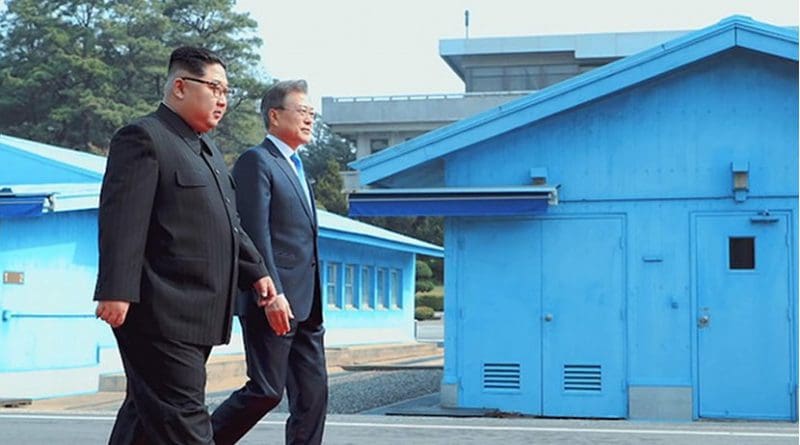Understanding Pyongyang’s Belligerence Towards Seoul – Analysis
By IPCS
By Dr Sandip Kumar Mishra*
On 16 June, North Korea blew up the Inter-Korean Liaison Office in Gaeseong. This is being seen as symbolic of South Korea’s failure to engage North Korea over the past few years. Effectively, North Korea has walked out of all agreements and understandings that have taken place between the two Koreas since the first half of 2018, including the Panmunjom Declaration. Kim Jong-un’s sister, Kim Yo-jong, who is first vice department director of the Workers’ Party Central Committee, used the occasion of the anniversary of the first Trump-Kim summit, to lambast President Moon Jae-in and South Korea with sharp rhetoric.
North Korea’s recent belligerence towards South Korea began with an over-reaction to ‘objectionable’ leaflets that called Kim Jong-un a “devil” who would meet the “same bloody fate as Saddam Hussein or Muammar Gaddafi.” A few South Korean conservative civil society groups were responsible for these leaflets. Pyongyang was not pacified even after Seoul announced a crackdown on such activities—the former characterised them as “provocations graver than gun and artillery fire.” North Korea threatened to break all relations with South Korea, suggesting that “the next action against the ‘enemy’ will come from the army.”
These developments are indicative of a larger trend over the past few weeks, in which North Korea has deliberately tried to ruin relations with South Korea. Leaflets and other materials such as Bibles, dollar bills, small radio sets, and memory sticks have been sent by South Korean civil society groups into North Korea, through air and sea routes, and using balloons and water bottles, from more than two decades. It had not elicited such an oversized reaction until now because Pyongyang has been well-aware of Seoul, or the state, playing no part in these activities.
However, this time, North Korea has chosen to go the route of issuing unusually strong, provocative, and often humiliating statements. On 4 June Kim Yo-jong announced North Korea’s consideration of destroying the Inter-Korean Liaision Office, and nullifying the defence agreement between the two countries. On 9 June, the Korean Central News Agency (KCNA) reported that the regime would cut off all communications with South Korea. Jang Kum-chol, who heads the United Front Department, warned on 12 June of possible military action against South Korea as a result of the break in trust between them. North Korean Foreign Ministry official Kwon Jong-gun said the following day that South Korea’s call for “denuclearisation must be abandoned” as they are “nonsensical.” On 16 June, North Korea destroyed the Liaison Office, and announced that troops would be sent to the Mount Geumgang and Gaeseong areas as well as sentry posts, and military exercises in border areas would be restarted.
The Moon Jae-in administration’s engagement policy towards North Korea has since come under heavy criticism. To avoid political fall-out, the South Korean Unification Minister Kim Yeon-chul resigned on 19 June, taking all responsibility for this so-called failure. The South Korea Defence Ministry, in a show of toughness, said that Pyongyang would pay a price if it took military action. The South Korean Blue House declared on 17 June that Seoul would not tolerate North Korea’s “unreasonable words and actions.” While Seoul is clearly trying to publicly respond to Pyongyang’s provocations, it is also aware that North Korean aggression is motivated by other important reasons that have little to do with their bilateral relationship.
One, North Korea is desperate for the removal of economic sanctions, which the US administration under President Donald Trump does not appear at all interested in. By being belligerent towards a neighbour and US ally, Pyongyang seeks to draw Washington’s attention to its own demands.
Second, North Korea has recently gone through internal political changes. Kim Jong-un appears to be suffering from health issues, and Kim Yo-jong has emerged in this time as the second most important leader in the regime. Kim Yo-jong is keen on a tough approach—she was involved in North Korea’s rapprochement with South Korea and the US, which unfortunately did not yield a wholly favourable outcome from their perspective. A tough image could help Kim Yo-jong rescue her image, and legitimise her ascendence.
Thus, North Korea’s recent provocations do not necessarily imply a failure of South Korea’s engagement policy. Rather, they are to suggest that the relationship, although bilateral, features an important third party, the US. Of course, political changes within the regime will also have a bearing on its approach towards inter-Korea relations. For these reasons, South Korea is best advised to be militarily prepared and positionally firm, even while maintaining a constructive policy approach.
*Dr Sandip Kumar Mishra is Associate Professor, Centre for East Asian Studies, SIS, JNU, and Visiting Fellow, IPCS.

